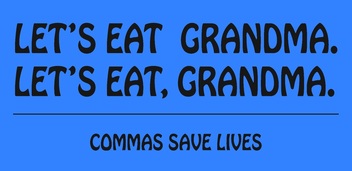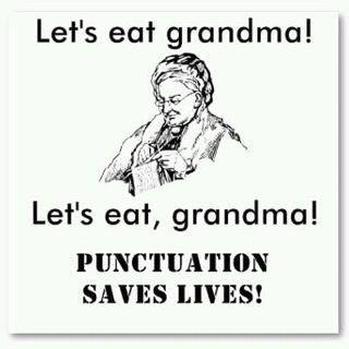 Writer and Polisher Christie was surprised this morning to receive a gift of a tee-shirt, bearing the legend at left. Our friend, Kathy Novak at ReMax Newport Realty is a fellow grammarista, and was so tickled by this that she had to share it! She had our mutual pals at Sign Shop of Racine (as you can see -- they do shirts, too!) make it up and brought it to our networking meeting earlier today. And, Christie has been wearing it and grinning ever since! Thanks, Kathy!
1 Comment
 Insert a comma when providing additional information that is secondary to the main point of a sentence. In grammar-speak, that is using commas to separate the main clause from subordinate and/or certain relative clauses.Examples can make this clearer:
In each of the foregoing sentences, some useful detail is lost by dropping the subordinate clause (before the comma in the first sentence and after the comma in the second), but the meaning of the sentence isn't affected. In practice, this means that commas will usually follow certain introductory phrases at the beginning of a sentence, including indicators of time or sequence, place, extent, cause, degree or condition.
Relative clauses are ones that begin with ‘who,’ ‘which,’ ‘that,’ ‘whom,’ or ‘where.’ They can go either way. Apply the 'essential to meaning' test to see if you need to use commas or not. In this case, the phrase will be set off before and after with a pair of commas. For example:
Similarly, other "aside" phrases or comments (‘of course,’ ‘indeed,’ ‘i.e,’ ‘eg.,’ etc.) that can be considered optional are also set off with commas.  Insert commas between coordinate adjectives. That is, words that equally describe something. If unsure, ask yourself if you can change the order of the adjectives without changing the meaning of the sentence. If so, they are coordinate, and should have commas between them. Example № 1: The orchestra played a slow, beautiful, familiar tune. Note that if one augmented the statement, like so: The orchestra played a slow, beautiful, vaguely familiar tune -- "vaguely" is describing (modifying) "familiar," so those two words stay together, undivided by a comma. Example № 2, one of the best insults ever written: "What kind of spindly, ricket-ridden, milky, wizened, dim-eyed, gammy-handed, limpy line of things will you beget?" (The Lion in Winter, 1968 -- delivered by Katharine Hepburn as Queen Eleanor of Aquitaine to Peter O'Toole's King Henry II.) Each of those delightfully biting adjectives equally describe "line of things," and the order is relatively unimportant (when rattling it off as a quote, we rarely get them in their actual order, nor the same arrangement twice). According to the test, commas go in between.  We have encountered postal abbreviations for state names in narrative text quite frequently, of late. So, it seems time for a reminder that while there are a couple of legitimate options when referring in writing to one or more of the constituent parts of these United States of America, the USPS abbreviations are not among them. It's understandable how people can get into the habit of thinking of the state in which they live, and probably also the neighboring ones, to which they are prone to regularly address postal mail, in terms of the postal abbreviations. Though the addressing of mail using the postal abbreviations is ubiquitous, it is still a rare person who knows all fifty of them. When familiarity is not universal, use in text can leave a significant part of the audience wondering if AL refers to Alaska or Alabama. So, it is generally only correct to use a postal abbreviation as part of an actual address block (on an envelope, at the top of a letter, conveying a third-party's address in the body of a letter, anywhere when street/city/ZIP code are present, etc.) Our advice, for the sake of simplicity, is that within text or anything resembling traditional sentence structure, you should write out the name of the state. If you're just looking for a basic instruction, you can probably stop reading now and go about your day. ---------------------------------------------- ~ On the other hand, if you're interested in some of the qualifiers and digressions, continue: In the matter of postal abbreviations, different style manuals handle these things differently. The Chicago Manual of Style (CMOS) prescribes the advice that Write and Polish dispenses above. It is a clean and straightforward solution with nothing to look up or memorize. However, The Associated Press Stylebook (AP) has a set of abbreviations (and non-abbreviations) that it adopts for each state -- the so-called "traditional" abbreviations that pre-dated the postal system's two-letter designations. The majority of newspapers follow AP style, and these handles do clearly convey the necessary information. However, the traditional abbreviations follow no simple rule, like "three letters, first capitalized, ending with a period." They're each their own thing, including the eight that are never abbreviated! So, for the average person writing everyday business or personal material, to follow AP, you would need to refer to a list each time unless you'd learned them. Now, Write and Polish, being concerned about the aesthetic appearance of information on the printed (or rendered) page, writes the state name in its entirety in text AND IN ADDRESS BLOCKS. Though the postal system (their optical readers, actually) wants universal use of its two-letter codes, at present, our preference for what we find to be a more elegant look does not interfere with delivery. We will also admit, when dealing with our own materials, to a streak of obstinacy in the face of government-instituted homogenization! This W&P choice illustrates what is known as "house style." How material is presented can support, detract, or be neutral with reference to the brand and the organization's culture. A business or institution will often choose a major style manual to act as a "base" for its written material, and then supplement it with brand-specific requirements and other exceptions that constitute its own, hopefully distinct, style. House style should still be consistent with understanding, but allows for leeway in a variety of areas. For example, as of this writing, explicit direction to include or exclude the comma before the terminal conjunction in a simple series has become a "house" style point, as in: We color-coded our edits in red, blue, and green. or We color-coded our edits in red, blue and green. The first presentation was once de rigueur, but has largely gone by the wayside as unnecessary and redundant. For those who feel strongly about retaining that comma, however, spelling out the expectation in an internal style manual ensures that it is done consistently throughout the organization. Holiday punctuation 9-1-1 received today: Oh, Guru of Grammar, I'm writing our holiday cards and I'm stumped. Should I use dashes or commas? "We've had a rockin'-awesome-crazy-wonderful-fantabulous-extraordinary-superb kind of year."
The answer in this example is to use commas. The dashes join a string of words or a whole phrase into a single word, for syntax/punctuation purposes. But you're just using a lot of modifiers as themselves...a string of modifiers. So, separate them with commas! The example I like to use is: She got that creepy, shivery, something's-under-the-bed feeling.... See how you have an example of both adjectives separated by commas and another set of words connected by hyphens to behave like another adjective in the list? Note: Adjective = a word that describes (or modifies) a thing 10/11/2011 0 Comments Why Language Has RulesFor a lot of people, it can be very easy to feel that the "rules" of grammar and punctuation are arbitrary and mostly there to confuse. This is an example of the fact that they perform actual jobs meant to clarify meaning.
Like any tools, however, it helps to know how and when and where to properly use them. |
Write and Polish BloggersChristie Manussier, principal Writer and Polisher, is the usual news reporter. CategoriesAll Abbreviation Academic Acronym Adjective Adverb Anachronism Anagram Apostrophe Application Article Banished Biography Blend B.N.I. Boldface Brochure Bunnies Business Business Plan Capitalization Children's Literature Christmas Church Comma Common Mistakes Construction Contact Management Content Contest Cross-sell Databse Differentiators Donation Double Negative E-mail Entertainment Etymology Event Coordination File Format First Reference Flyer Fundraiser Giggles Gold Star Grammar Day Grant Proposal Haiku Health Care Homophones Hyphen Idiom Images Italics Law Firm Magazine Manual Marketing Maternity Leave Metaphor Myth News & Announcements Newsletter Non Profit Non-profit Noun Numbers Of Snakes And Presidents Parts Of Speech P.D.F. Plural Poetry Portmanteau Poster Powerpoint P.R. Preposition Press Release Projects Pronoun Proofreading & Editing Punctuation Quotation Marks Quotes Real Estate Recommended Reading Reflexive Research Resources Restaurant Retail R.F.P. R.I.P. Shakespeare Slideshow Social Media Spelling Style Manual Synonyms Syntax Template Tenses Testimonial Thesaurus Training Manual Translation Travel Twitter Underlining Verb Video Vocabulary Website Why The World Needs More Proofreaders Winter Word Of The Day Writers Writing Tip Archives
March 2015
|
Search by typing & pressing enter


 RSS Feed
RSS Feed